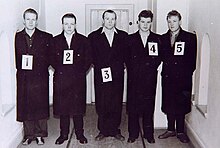
A police lineup (in American English) or identity parade (in British English) is a process by which a crime victim or witness's putative identification of a suspect is confirmed to a level that can count as evidence at trial.
The suspect, along with several "fillers" or "foils"—people of similar height, build, and complexion who may be prisoners, actors, police officers, or volunteers—stand side-by-side, both facing and in profile. There is crucial information that should be conveyed to the eyewitness prior to viewing the lineup. It is necessary to inform the eyewitness that it is possible the perpetrator is not present in the lineup.[1] The eyewitness should also be told that they do not have to choose one of the people from the lineup. Including these details has shown to result in fewer misidentifications.[2] The lineup sometimes takes place in a room for the purpose, one which may feature a one-way mirror to allow a witness to remain anonymous, and may include markings on the wall to aid identifying the person's height.
For evidence from a lineup to be admissible in court, the lineup itself must be conducted fairly. The police may not say or do anything that persuades the witness to identify the suspect that they prefer. This includes loading the lineup with people who look very dissimilar to the suspect.[3]
- ^ Dittman, M. "Recommendations for police lineups". American Psychological Association.
- ^ "Increasing Eyewitness Accuracy in Police Lineups". American Psychological Association.
- ^ "Where do police get the people for lineups?". The Straight Dope. November 21, 2006. Archived from the original on April 30, 2008. Retrieved July 7, 2007.